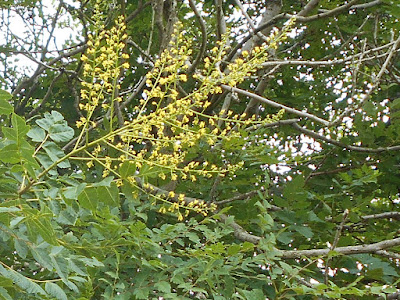The play was set in Ireland but Lughnasa, pronounced Loon'asah, is a pagan festival once celebrated throughout the Celtic world. The Saxons in England called it hlaf-mas; we could call it loaf-mas but instead we refer to it as Lammas. And the First of August is Lammas Day.
Traditionally it was the first day of harvest; the day when the farmer would take his scythe and cut the first sheaves of corn. Hopefully, by nightfall his wife would have baked the first loaves of the season. It was a time to celebrate, and festivals were held to commemorate this vital event. The modern calendar often fails to mark the occasion and it is almost forgotten in England but in some European countries it is still a time for rejoicing and in the United States there has been a revival of interest in this festival.
For botanists it has another significance, for today I went in search of oak trees to photograph examples of lammas growth. This is growth put on by trees at around mid-summer, probably to compensate for the damage caused by insects during the previous three or four months. It is particularly obvious on oaks with the new foliage standing out bright or pale green against the older leaves with their coating of yeasts and sooty moulds often looking almost black.
 |
Pale new Lammas growth on an oak near Staverton Road, Daventry.
1 August, 2017
|
Many trees produce this fresh growth and I noticed birch trees displaying similar foliage but despite a long search I found no ash trees showing this phenomenon.
 |
Lammas growth on a birch tree, Staverton Road, Daventry.
1 August, 2017
|
On a different topic, but sticking with trees, my walk also provided me with a surprise for one garden held a fine example of Koelreuteria paniculata. This tree is not often seen in Britain although I have seen it used as a street tree in the south of Europe.
 |
Koelreuteria paniculata, in Drayton, Daventry.
1 August, 2017
|
It is sometimes known as Pride of India, a quite inappropriate name as it is not from India at all but is a native of China. Its panicles of yellow flowers were rather too high for a decent photograph - but I did my best.
A Lammas Chant
By Hoof and horn, hoof and horn,
All that dies shall be reborn;
Corn and grain, corn and grain,
All that falls shall rise again

No comments:
Post a Comment